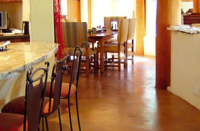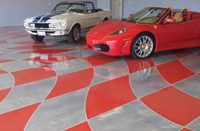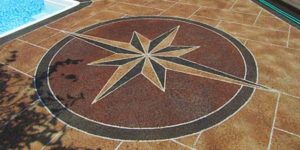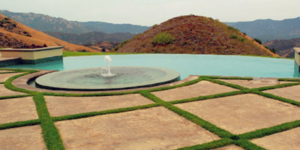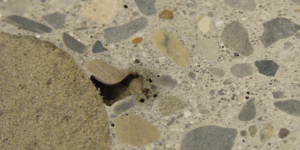
In the world of home aquatics, salt-chlorinated swimming pools are all the rage. Also known as salt-water pools, they’re purportedly gentler on the skin and eyes. Apparently, though, they’re harsher on the concrete pool deck.
We talked to a selection of industry experts — concrete experts, pool people, concrete product manufacturers — and there are a variety of opinions as to whether there really is a problem, and what that problem is. However, a majority of our experts believe there are real issues involving concrete sealers around salt-chlorinated pools.
Salt water is aggressive. In the mid-2000s, as salt-chlorinated pools started to soar in popularity, reports of problems involving deterioration of stone copings began to crop up. Softer, more porous stone — certain limestones, for example — were apparently being eroded on pool copings and deck areas where there was consistent splash-out. Freeze-thaw damage was being reported. The solution offered was to seal the stone.
Issues with concrete appear largely to involve sealers used to protect decorative concrete. They are suffering delamination. It can appear as light spots on the surface. Sometimes the spots are quite large.
Scott Creager, owner of Creager Decorative Consulting Inc., Dallas, Texas, is quite definitive that salt water is destroying sealers.
“Salt attacks sealers. It eats through the sealer and causes the sealer to delaminate and fail on top of your colored concrete. It’s not just related to concrete, it’s eating up the ladders and the rock water features, too.”
According to Creager, it usually takes two years or more, occurring mostly in places where there is frequent dripping water or where there’s greater traffic wear.
Rick Cofoid, sales manager at materials manufacturer Increte Systems, is also certain there is a problem with sealers around salt-water pools. “We’re seeing flaking and delamination of acrylic sealers, whether it’s over stamped concrete or a textured spray-down, knock-down surface.”
He describes troubleshooting a pool deck at a retirement home in Virginia. “They had applied our Spray-Deck cementitious product and had an acrylic sealer. When the deck was constructed, it was a conventional chlorine pool. A year later they switched to a salt-water pool. They had an area of flaking where they were putting wet kickboards and where people were walking out of the pool. It would only happen where they had a crack in the concrete or there was a control joint.
“You could tell that the concrete underneath was basically scaling. Our stuff still had a thin layer of concrete attached underneath. They never had a problem until they put in the salt system.”
This description suggests that a problem can occur even without sealer failure if the salt water can find its way around a sealer edge, such as at a crack. The fact that the sealer bond held, but the concrete itself failed, seems significant.
Cofoid’s observations of the problem are very specific. “Typically big areas flake. I think it starts with little pinholes and places at control joints, because water finds a way. Like cancer, it starts off small, probably a spot you can’t even see. In a short amount of time it starts to flake and spreads from there.” He believes it can happen in 4-5 months.

Don’t simply blame salt water
Scott Cohen, artisan and construction defect expert witness, whose company The Green Scene makes decorative backyards and pools in Southern California, has observed problems around salt-chlorinated pools too, but he is far from certain that all salt pools are problematic.
“I’ve seen examples of cast-concrete pool coping eroding more quickly,” states Cohen. “I’ve seen the premature demise of sedimentary stone and flagstone in waterfalls, pool copings and patios, as well as excessive pop-outs. It occurs predominantly in areas that are wet, then dry, a wet-dry cycle. Water evaporating leaves behind salt crystals. Halite can be very powerful in the breaking up and lifting of concrete. The minerals seem to absorb into the concrete, that then pops.”
Cohen recalls an incident that brought home to him the cause-and-effect chain. “I was sitting with clients in their backyard and we were talking about designing their next home. They said they definitely did not want stamped concrete around their pool decks, and showed me concrete that was chipped and flaking. It was only in this one 15-foot area. Then their dog jumped into pool, came out, and shook himself off in that one particular place.”
Cohen is not convinced that the real cause of the problem has been identified. “When we see a problem in the field, we don’t have a control pool to refer to.” He points out that pool chemistry is delicately balanced and not always maintained properly. “We can’t blame the damage on all salt-system pools. We can say that it’s important to manage the levels of salt to make sure it’s balanced. In my opinion, the jury’s still out.”
Acids are known to deteriorate concrete, and pool water can become too acidic if not properly monitored and rebalanced as needed. Salt-chlorinated pool chemistry, however, tends to shift in the other direction, becoming too alkaline. The exact mechanism of the problem has not been definitively identified.
Chris Sullivan, vice president of sales and marketing with ChemSystems Inc., does not believe there is a particular problem with salt-chlorinated pools. Most of the problems that he has seen are attributable, he believes, to inadequate maintenance. “Any pool water, chlorinated, salt or brominated, it has a lot in it. As water inevitably gets out of the pool and lands on the pool deck, the water evaporates, and the mineral content in the water ends up on the deck surface as a white haze. It may be more prevalent in regions where you have high mineral content in the water to start with. When the water evaporates, those minerals are going to be left on the surface. There’s no way to avoid it. Eventually, you’re going to get deposits.
“Salt itself is not going to eat or affect the plastic layer of sealer,” Sullivan states. “(But) if you don’t have good adhesion between sealer and concrete, when water gets underneath that sealer, it can cause the sealer to delaminate. If liquid water sits on most of these sealers long enough, it will get through.
“These acrylics are a sacrificial coatings that last 1-3 years, depending on the product. They’re designed to be reapplied.”
Solutions
Assuming you believe there is a problem, what can you do about it?
Chris Sullivan suggests penetrating sealers that will repel water. “For a pool deck, I like silanes or siloxanes. There’s no film. Unfortunately, they do not eliminate the white haze that forms from mineral deposits, but that can be cleaned with very, very mild acids, vinegar, or if you need something stronger, muriatic acid diluted 50:1. If it’s sealed properly, the acid won’t touch it. The products made for shower-cleaning typically work as well.”
Dave Flax of Euclid Chemical agrees about penetrating sealers. “The problem with anything on the surface is that it can wear off the surface. It should be a penetrating sealer.”
Tyler Irwin of Proline Decorative Systems is against using acrylic sealers around pools. He has observed sealers being attacked by conventionally chlorinated pool water as well as salt water. Acrylic sealers around pool decks “require much more maintenance than on a typical patio application.” He also feels they create slip-and-fall hazards around pools. “The biggest problem (with colored concrete near pools) is that when you want to color concrete, you have to seal it, and the sealer is where you run into big problems.”
Irwin’s solution is to have an unsealed surface. He suggests a textured finish, and for color, an antiquing wash such as Proline’s EZ-Tique, a cementitious product with iron oxide pigments in it. “It just crawls into the nooks and crannies of a textured or stamped surface,” he explains. “It’s in the low spots, so traffic won’t wear it off.”
Irwin feels integral color is also a viable option. “Everything fades to some degree, but iron oxide pigment (in integral color) is as close as it gets. It is considered UV-stable by industry standards.”
But again, he cautions against sealing the concrete with any sealer, because in his experience, sealers around pools are prone to problems. “For my taste, I would go for a natural stone look around a pool. It‘ll always look good, and it’s easy to maintain. The glossy Vegas look will wear in about a year.”
Cohen is also against sealers near pools, because of slip-fall hazards. “Anytime we seal concrete around swimming pools, we increase the slipperiness. I’ve yet to find a sealer that meets its claims in being nonslippery around a swimming pool.
He also refuses to deal with salt-water systems. “At my company, because of the uncertainty of the effect of salt water on pool decks, and because of what I’ve seen investigating problems, we don’t offer salt-water pools.”
For those who have salt-chlorinated systems, Cohen advocates washing them down frequently, and points out that he’s not alone. “The salt system manufacturers recommend washing your pools decks down with fresh water after each use. It’s a good idea to add it to your maintenance schedule, to reduce impact of salt water on patios and coping.”
For those who want sealers, there are some available that are specifically marketed for salt-water resistance, such as DuPont StoneTech Professional Salt Water Resistant Sealer. Though designed primarily for stone, it is also applicable to concrete. Rick Cofoid reports that his company, Increte Systems, is working on a solution to the problem, but it is still in the R & D phase.
